jamesp
Cave Dweller 
Member since October 2012
Posts: 36,612
|
Post by jamesp on Jan 10, 2015 13:05:33 GMT -5
snowmom must be a vigorous child, if she carried this chunk home. Dense as a meteorite. It is a breccia, I hope she will describe it's origins. She uses big words. It was also a mouthful for my saw. Will send her back a nice fat slab out of the center so she can get lost in it's features. It has breccias within in breccias within in breccias.......................many generations of breccias. Not sure what happened up there, but it must have been very violent. The whole cobble 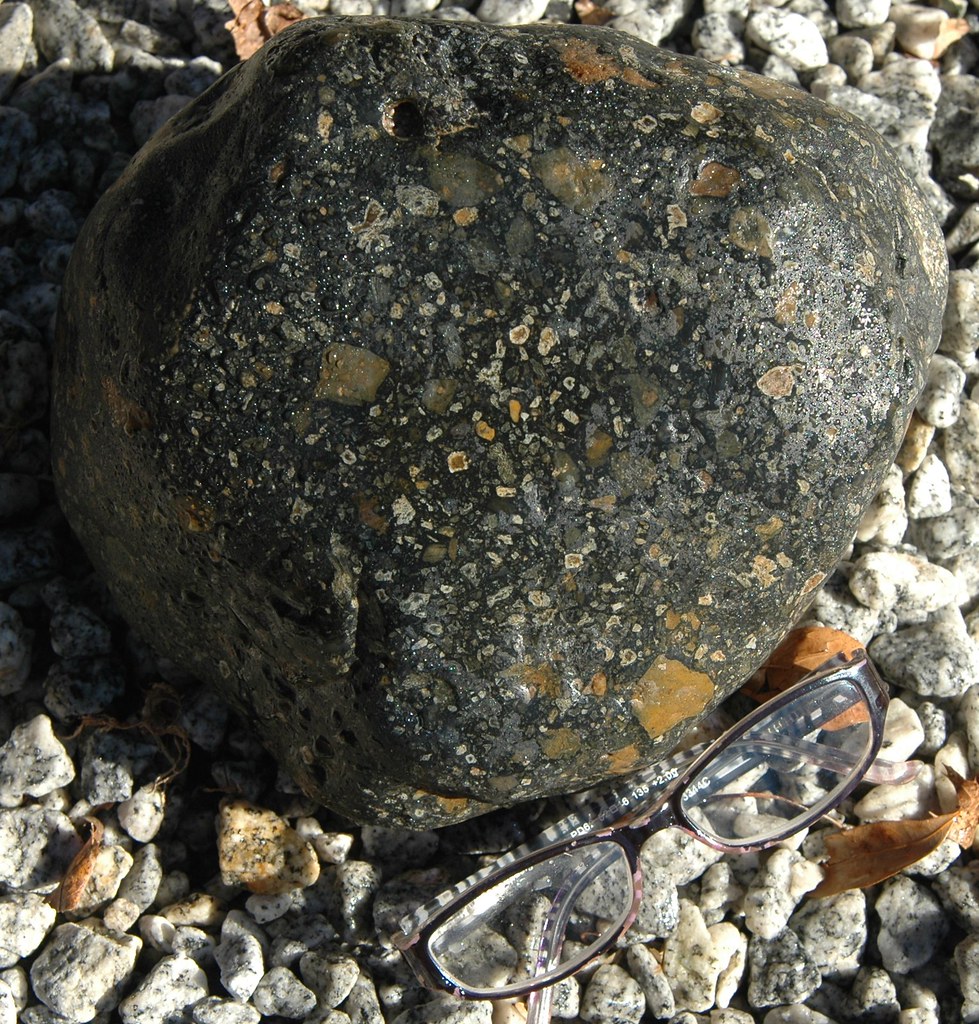 close up of surface 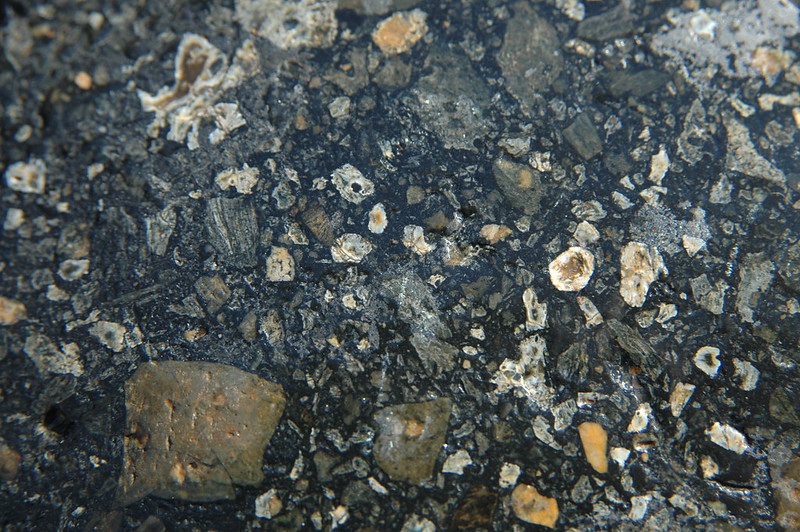 a heel cut away  some macros of the heel  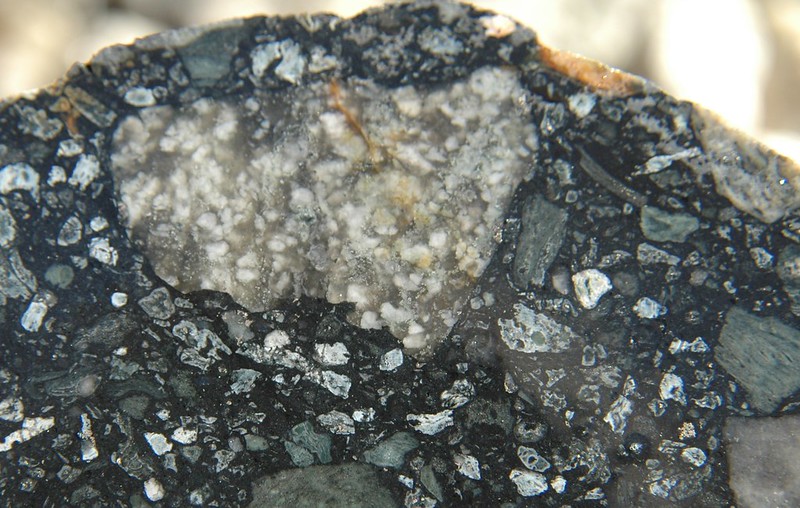 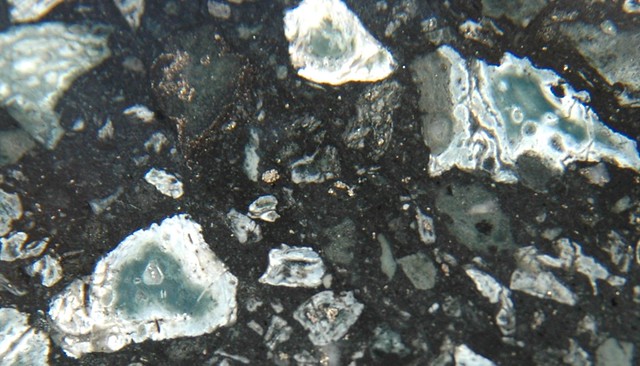 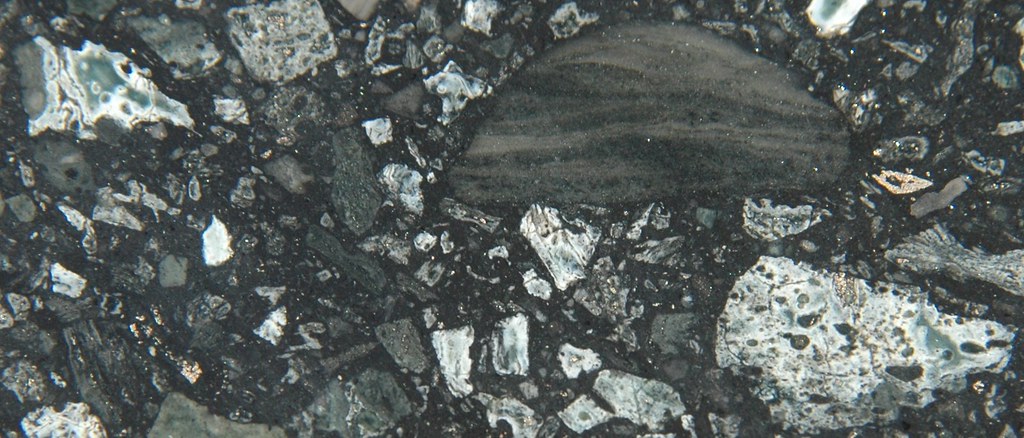 More stuff with winter sun low in the sky poor photo 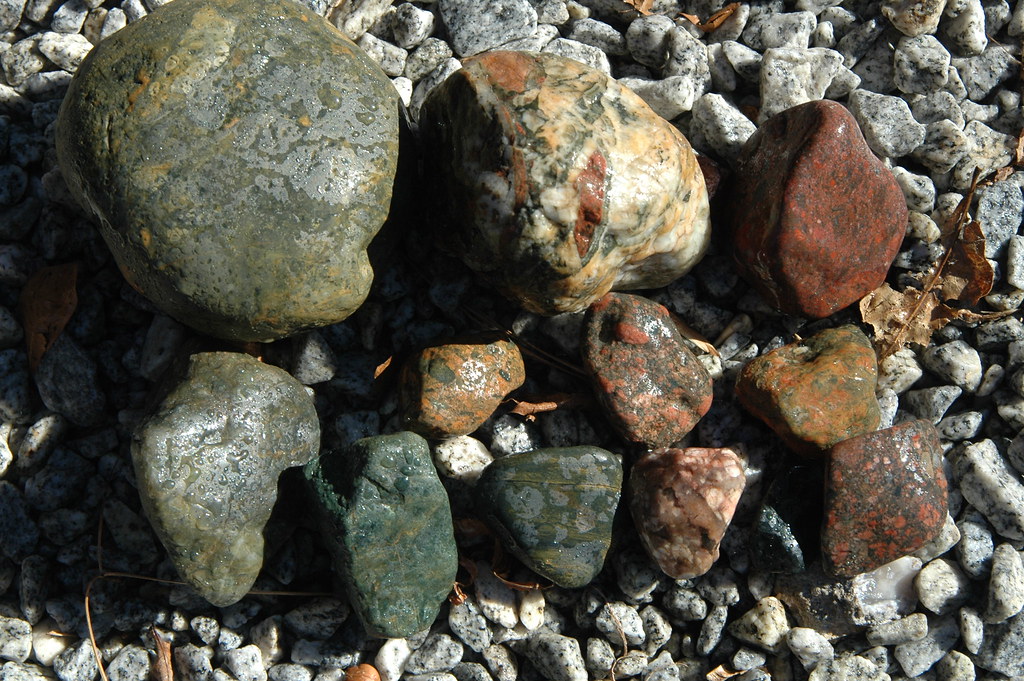 Thanks snowmom, these are some beautiful rocks
|
|
|
|
Post by fantastic5 on Jan 10, 2015 14:15:04 GMT -5
WOW!!! That breccia is super cool! Keep posting pictures as you slab further.
|
|
|
|
Post by braders on Jan 10, 2015 19:09:22 GMT -5
Nice trade with the crazy rock lady lol  Thanks for the close up pics pretty cool |
|
jamesp
Cave Dweller 
Member since October 2012
Posts: 36,612
|
Post by jamesp on Jan 10, 2015 20:18:18 GMT -5
|
|
|
|
Post by snowmom on Jan 10, 2015 20:59:15 GMT -5
WOW James, I'd never get photos that cool of that stuff. both cut pieces shown are impactite,or suevites. the result of the Sudbury Ontario Canada (comet) impact. Second largest cratering event known to the world at this point. Very violent indeed. We are only 150 miles from the impact site straight across Lake Huron.
Lots going on there in the black Onaping melt material(first rock), and much more "gemmy" inside once
we get past the worn exterior. Who knew? Isn't it cool that you can see the way the stuff was shattered? The "powers that be" who decide these things think the black matrix was just instant puddled rock and the pieces that got blown into the sky in the impact fell back into the black soup to become breccia of shattered rock as it all cooled. believed to be mostly olivines, epidotes, and feldspars with jaspers and some quartz.
In the green one, The little rings around so many of the pieces are where melt rock surrounded the pieces and "flowed" some of them melting the surface of the broken rock a bit as well. Sometimes little spatters of melted rock which was vaporized in the impact (think fog turning to rain) fall back when they are still soft and become one with the melt rock. Those are accretionary lapilli. Sometimes I find some which just look like little piles of round rock stuck together. Some are larger or smaller and sometimes melted feldspars or granites which still show a bit of their original character. Sometimes some of them look a bit like Ocean Jasper with the round eye like effect that you can sort of see in a couple on the bottom(green)Onaping. Onaping comes in 3 forms, black, green, and grey. The black has the smallest pieces, then the green, then the gray. I understand the green is not quite as common as the other 2. They are thought to represent different stages of the melt process which happened at impact, the whole thing having taken just moments to melt. I don't see any bits of metal, and I don't remember if I checked those particular ones for magnetism. I have a couple that attract a magnet a bit, but not all of them do. Thanks for posting pictures, the big green cobble was driving me crazy to know what it looked like inside! Going to save all these pictures to my files for reference. Wonderful!
|
|
|
|
Post by kap on Jan 10, 2015 21:58:12 GMT -5
Cool! I looks sotra like Rain Forest Jasper also.
|
|
Fossilman
Cave Dweller 
Member since January 2009
Posts: 20,723 
|
Post by Fossilman on Jan 10, 2015 22:09:02 GMT -5
That rock has a lot going on with it! Awesome....
|
|
Deleted
Deleted Member
Member since January 1970
Posts: 0
|
Post by Deleted on Jan 10, 2015 22:19:00 GMT -5
Wow, this is similar but definitely different than the diatreme facies kimberlite she sent me. Wow! A Hedwig tells me DFK in lapidary form may be visible quite soon. Cannot wait to see jamesp's results with this related material. |
|
Deleted
Deleted Member
Member since January 1970
Posts: 0
|
Post by Deleted on Jan 10, 2015 22:20:19 GMT -5
Jim, please make thoughtful comparison to bcrockhound's Dallasite. |
|
|
|
Post by Drummond Island Rocks on Jan 10, 2015 22:44:07 GMT -5
Jim, please make thoughtful comparison to bcrockhound's Dallasite. I was thinking the same thing. I have some dallasite slabs that are very similar looking. Here's some dallasite cabs I did for quick comparison  link to close up photos  Chuck |
|
Deleted
Deleted Member
Member since January 1970
Posts: 0
|
Post by Deleted on Jan 10, 2015 22:48:03 GMT -5
Drummond Island Rocks I take zero credit for the observation. Tommy made that to me privately. The halos in this one 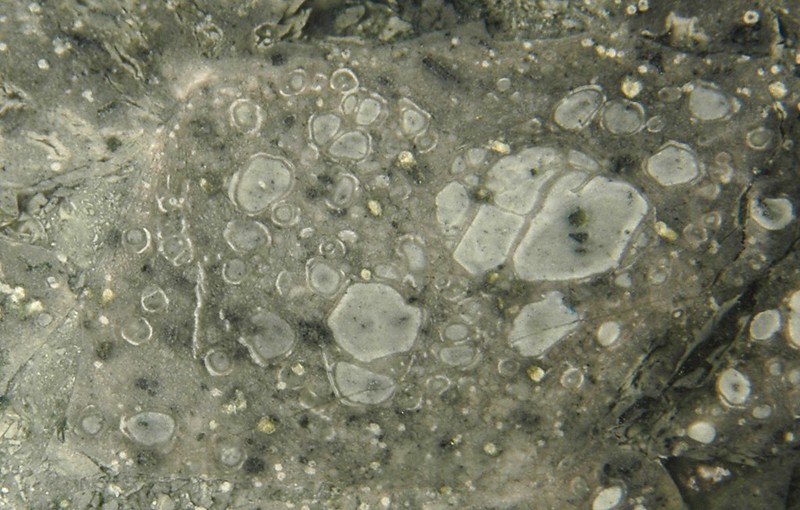 look like the diatreme facies kimberlite she sent me. 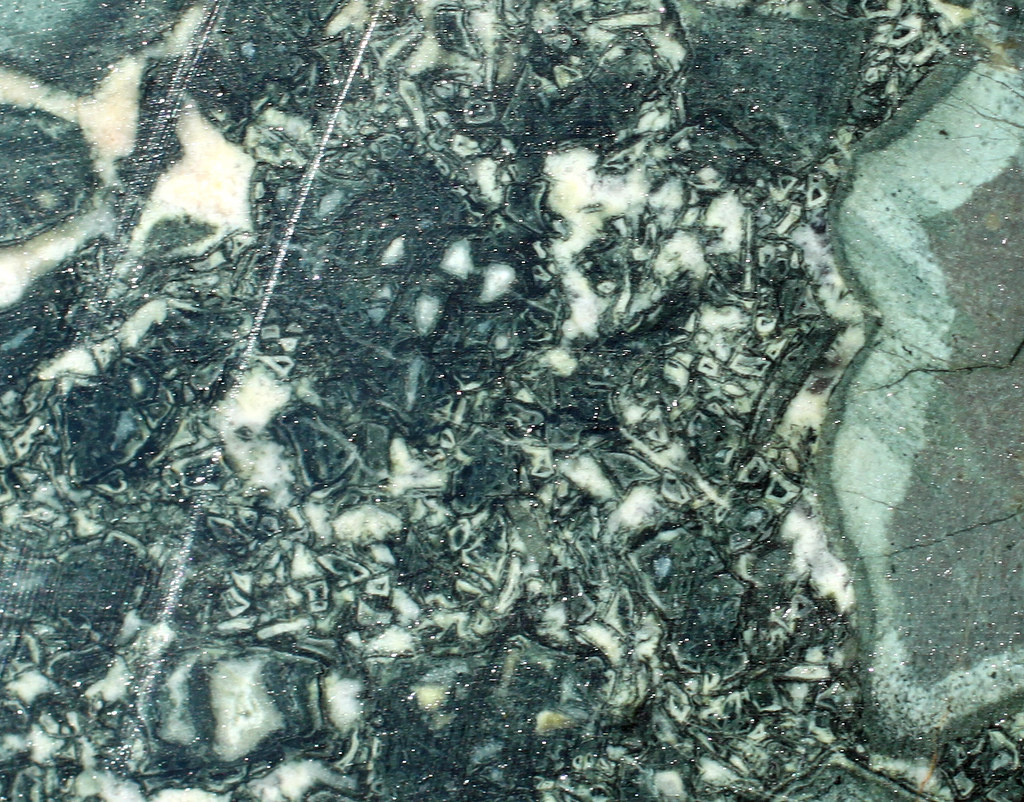
|
|
Deleted
Deleted Member
Member since January 1970
Posts: 0
|
Post by Deleted on Jan 10, 2015 22:48:59 GMT -5
I think I would call it Dracula Pudding Stone. Cool whatever she said. Can you say obsessive/compulsive? Lovin it.
Jim
|
|
Deleted
Deleted Member
Member since January 1970
Posts: 0
|
Post by Deleted on Jan 10, 2015 22:54:36 GMT -5
Drummond Island Rocks I take zero credit for the observation. Tommy made that to me privately. The halos in this one  look like the diatreme facies kimberlite she sent me.  Has anyone else noticed the graph line that goes from lower left to upper center over a hump? Looks like the bubbly part was slammed into the part on the upper left. Jim |
|
jamesp
Cave Dweller 
Member since October 2012
Posts: 36,612
|
Post by jamesp on Jan 11, 2015 4:51:47 GMT -5
Jim, please make thoughtful comparison to bcrockhound's Dallasite. I made comment about that similarity Scott. They look similar to bc's dallasite. Those rocks are devoid of fractures, nada, like a casting. Another pre-shaped by mother nature sphere candidate. Like Rio Grande pebbles, except bigger and rounder and less cracks. SW Costa Rica, near San Isidro, the big river there fires of the 10,000 foot decent to the Pacific in a short distance, 2-6 foot cobbles, almost all are very close to spheres. I suppose the Great Lakes are real rock rounders too, or the complicated geology created them. i sent snowmom the center slab from that big cobble, 1 inch thick, and it had a ring to it at that thickness, must be hard rock. It filled a SFRB in height and width and almost thickness. it is a beaut. |
|
jamesp
Cave Dweller 
Member since October 2012
Posts: 36,612
|
Post by jamesp on Jan 11, 2015 4:53:50 GMT -5
Nice trade with the crazy rock lady lol  Thanks for the close up pics pretty cool Look what she has to go through to explain the birth of her local rocks brader, ha, if I had to spit that mouthful out I would be crazy too LOL the geology up that way is complicated, no doubt. No telling what kind of alien creatures roam that area, that road in on that giant comet. snowmom may be an alien, ya never know..... "WOW James, I'd never get photos that cool of that stuff. both cut pieces shown are impactite,or suevites. the result of the Sudbury Ontario Canada (comet) impact. Second largest cratering event known to the world at this point. Very violent indeed. We are only 150 miles from the impact site straight across Lake Huron. Lots going on there in the black Onaping melt material(first rock), and much more "gemmy" inside once we get past the worn exterior. Who knew? Isn't it cool that you can see the way the stuff was shattered? The "powers that be" who decide these things think the black matrix was just instant puddled rock and the pieces that got blown into the sky in the impact fell back into the black soup to become breccia of shattered rock as it all cooled. believed to be mostly olivines, epidotes, and feldspars with jaspers and some quartz. In the green one, The little rings around so many of the pieces are where melt rock surrounded the pieces and "flowed" some of them melting the surface of the broken rock a bit as well. Sometimes little spatters of melted rock which was vaporized in the impact (think fog turning to rain) fall back when they are still soft and become one with the melt rock. Those are accretionary lapilli. Sometimes I find some which just look like little piles of round rock stuck together. Some are larger or smaller and sometimes melted feldspars or granites which still show a bit of their original character. Sometimes some of them look a bit like Ocean Jasper with the round eye like effect that you can sort of see in a couple on the bottom(green)Onaping. Onaping comes in 3 forms, black, green, and grey. The black has the smallest pieces, then the green, then the gray. I understand the green is not quite as common as the other 2. They are thought to represent different stages of the melt process which happened at impact, the whole thing having taken just moments to melt. I don't see any bits of metal, and I don't remember if I checked those particular ones for magnetism. I have a couple that attract a magnet a bit, but not all of them do. Thanks for posting pictures, the big green cobble was driving me crazy to know what it looked like inside! Going to save all these pictures to my files for reference. Wonderful!" Read more: forum.rocktumblinghobby.com/thread/69142/snowmom-swap?page=1#ixzz3OVNrhX8q |
|
jamesp
Cave Dweller 
Member since October 2012
Posts: 36,612
|
Post by jamesp on Jan 11, 2015 5:08:47 GMT -5
onaping IMPACTITE official avatar  |
|
|
|
Post by snowmom on Jan 11, 2015 5:17:05 GMT -5
Jim, Wampidy I resemble that remark! Mohammed Cartoon, I have talked it over with Stew and also with the owners of a rock shop in Vancouver BC which handles a lot of Dallasite. They both say it is very similar. But not quite the same. I suspect the native rock is similar in composition, olivines,(epidote and peridot) basalt, orthoclase and quartz. Both having come from deep beds of Canadian Shield material. It seems to me high heat of any sort might have similar effects if the materials we started with are similar as well. Mohammed Cartoon, je suis Charlie. JamesP, Did you see on the outside of that (second photo green rock) before you cut it, all the glassy threads of melt rock which encircled it and how it resembled a sphere? I think it was formed when it hurled through the air as melt, and the smushed side would show where and how it landed. The earth was covered with water and a huge tsunami would have been produced at the same time along with backwash, most likely it landed in water when it came to rest. I have many rocks which seem to be "melt bombs" shaped like tektites in round or oval with a sort of point at one end, but larger than most photos of tektites I have seen, most of them fist size or just a bit smaller... I keep wondering if that is what they might be. There are some posts out in the world of Google which would seem to confirm it, but I don't find much about it. I did find a test which would confirm if it was volcanic or meteor melt glass. a small piece of material is heated to melting with high heat flame such as a welding torch. Any bubbling would indicate earthly(volcanic) heating, if it drooped and melted but stayed intact with no bubbling, it has been super heated as in meteor origin... unfortunately if it is a tektite, it will shatter as it cools and nothing will remain but tiny shards. so best done on a small piece of the subject rather than the whole thing! No fun to confirm you have a tektite only to have it vaporize itself after the test.  I don't have the facilities to perform such a test, but the results would be interesting! |
|
|
|
Post by snowmom on Jan 11, 2015 5:21:02 GMT -5
JamesP, it surely must have looked a lot like that!
|
|
jamesp
Cave Dweller 
Member since October 2012
Posts: 36,612
|
Post by jamesp on Jan 11, 2015 5:40:08 GMT -5
Nothing like hard evidence. The two impact stones needed scrutiny because of their most interesting creation.
Seen a few impact stones that did not float my boat, these are the best examples of impact material.
Like they tell a clear story. A layman can read the story behind them and relate to the patterns in the rock.
Never thought about the shape. You should post some examples, or when the ice goes away take some field photos of the shapes.
Shape/size, interesting to see how big those impactites are, a car, a house ?
|
|
|
|
Post by snowmom on Jan 11, 2015 5:46:07 GMT -5
Nice trade with the crazy rock lady lol  Thanks for the close up pics pretty cool Look what she has to go through to explain the birth of her local rocks brader, ha, if I had to spit that mouthful out I would be crazy too LOL the geology up that way is complicated, no doubt. No telling what kind of alien creatures roam that area, that road in on that giant comet. snowmom may be an alien, ya never know..... SHHHHH Don't Tell! |
|